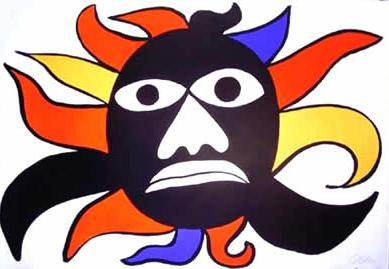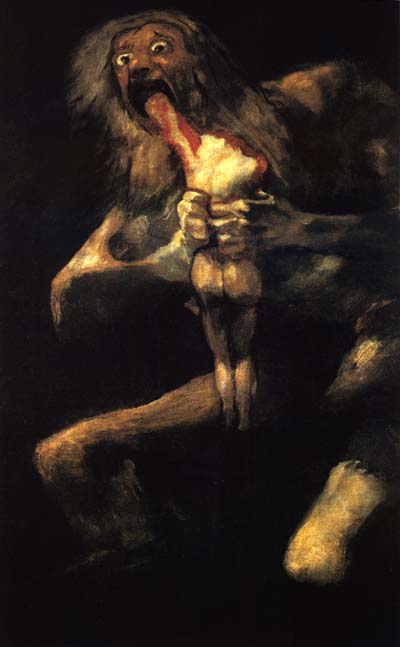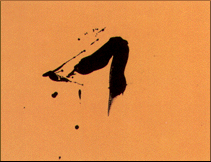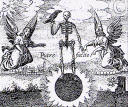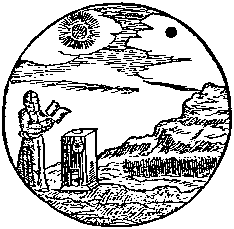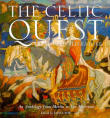|
Disclaimer: This unedited, rough draft material is a year-long project in response to our 2004 theme: pilgrimage. It is meant to be a dialogue between myself and my fellow Mammoths and any of you who happen along. It is intentionally not polished, nor is it finished. Charlie Buchman Ellis --------------------------------------------------------------------------------
The Jungian path twists, deepens, opens. Stan Marlan today on Sol Niger, the Black Sun. He’s a melancholic guy (his description) who’s found, at the center of his psychic universe—and, coincidentally, yours and mine, too—a melancholic image. Even so, as with, just because your paranoid doesn’t mean someone,s not out to get you, so, being melancholic doesn’t mean you can’t find a hidden truth with sadness and grief etched in it. Oooff. Triple or quadruple negative there. Still. Negative. Negating. Negrito. Sol Niger. The black luminous star. Marlan makes a point, or, rather, reiterates a point made by Hillman, that the character of black is not simple. Take the issue of color, for instance. The Enlightenment position, articulated by Newton, who as an alchemist himself probably knew there was more than one perspective, made it easy: white, as demonstrated by the prism, is all colors blended together, and black, the converse, the absence of color. Never mind how an absence can be definitive of a something. Hillman thinks, and I agree, this is a very narrow way to define a color; not to mention the way it misses the cultural determination nature of color. Here’s the point: black absorbs meaning; it has meaning; we could even say, it is meaning. In the European West black shows grief, mourning, describes night and is, therefore, the opposite, not of white, but of light itself. Its meanings may shift from culture to culture, but it has meanings within each culture, as do the other primary colors: red, yellow, blue—and some others, too: green, brown, for instance. Marlan illustrates his point well with examples from Western art. Here are a few images:
Goya, “Saturn”
And material from the strange world of Alchemical imagery:
Black Sun, Black Moon
I located most of these on my own, Marlan has others, but this batch illustrates the black sun as an enduring symbol and image, and the power blackness has to confound our usual expectations, to throw us into a different imagistic world. You each know, I’m sure, the sad correlations of blacks’ moral connotations with individual of dark skin color, most often in the brown range, so I won’t recount them, but it is important to acknowledge them and to declare them exorcised, or at least, to declare them in need of exorcism if they appear.
With the completion of Marlan’s lectures on the Black Sun the Jungian seminar came to a close for the year. In general I found the seminar intellectually stimulating, the participants interesting and supportive folks, and the deepening of my knowledge of Jung a valuable path. In playing with the pilgrimage metaphor I wonder if the seminar, or any long term educational process like it, constitutes a pilgrimage in its own right, or, whether it is a side path, one I take for, say devotion to a certain saint—Saint Carl Jung and his monks, the Jungians. Does pilgrimage, in the life as pilgrimage sense, really constitute several, parallel pilgrimages? Perhaps some of short duration—the traditional pilgrimage, say to St. John De Compostela, Syria, or the Hajj, or going home—with a narrow focus, and others, perhaps life long or years in the taking, say self-discovery, faith, husband, gardener, parent, artist, scholar. The Jungian seminar, a degree, a cherished hobby might be a mid-length pilgrimage, closer in spirit to the traditional pilgrimage with the narrower purpose, time set aside from day-to-day life, a particular destination. The larger, more complex image I have now is a baroque metal filigree, spirals and curves and floral designs branching off a thick central path, say the eternal spiral, done so all the paths flow toward the end, and come back, at some point to the thick central path, join it, and perhaps branch off once more, only to return yet again, later, further along. If we take this image as at least suggestive, we could take stock of our various pilgrimages from time to time, see how each one fares, perhaps look for synergistic moments among or between them. We could also see where new pilgrimages might augment or build on others. Sheila Asato and the drawing class, an outgrowth of the Jungian seminar, adds to my Southeast Asian journey, for example, yet, learning to draw constitutes a path of its own. In this trip I have the long-haul sacred journey of nuclear family blended with an episodic pilgrimage created by trips to lands outside my native Midwest. To increase the depth of this pilgrimage my work with Jung and image intersects my ongoing travel journaling. I will illustrate my journal this time, as well as write. Then, an ongoing sacred journey with the world of art has linked my ongoing journey into the Minneapolis Art Institute’s collection and through it to art history with the arts and architecture of Southeast Asia. Last, and far from least, my spiritual pilgrimage, my soul’s journey always has a complex and unexpected reaction to travel, a reaction which seems correlated to the degrees of separation from my own culture. Scott and I met yesterday at Gyatsho’s small apartment in North East Minneapolis. It is a modest three story walk-up, modern buff-brick and insulated windows, soiled hall-way carpets, a darkened dark green. His home is spotless. It has an American altar—Sharp’s 27 inch TV with a native american woman holding either a moon or an eagle on top of it—but otherwise feels like the home of a man comfortable in his new country, yet not of it. He took my purple tulips and disappeared while Scott and I waited, admiring his thangka of White Tara, a banner with what Gyatsho later told us was Sanskrit, which he reads, a beautiful silver bowl on an interesting coffee table with table supports made of a thick lattice of squares. The couches had what looked like rugs on them though they were comfortable, not stiff as I imagined they would be. The dining room table looked handmade with turned and painted legs. After we discussed Gyatsho’s past, he was born in Sikkim, moved to India for college when he was young, then went on to Tibet to study Tantric Buddhism with private lamas in Lhasa for six years while working half-time as an interpreter for the Indian consulate. He speaks English with a definite Indian rhythm. At some point he went Dharam-Sala with the Dalai Lama where he used his knowledge of the Indian government to help create necessary institutions like schools, hospitals, and, eventually, his obvious personal favorite, the Library for Tibetan Culture. The Library is closer to a Tibetan Studies college since it offers classes in Sanskrit and Tibetan, teaches and supports Tibetan artists, and has as its key mission publications in English of work by scholars on Tibet, and, of particular importance to Gyatsho, publication of work by Tibetan scholars translated into English. In addition it serves an archival role for Tibetan manuscripts, art, sacred objects, and other objects of material culture which preserve life and customs and religious practice of Tibet prior to the Chinese occupation. After he organized the library Gyatsho spent much of his time translating the work of Tibetan scholars and editing a journal, now in worldwide circulation, Tibet Journal, which he created in 1976. It is now the only longest lived journal of Tibetan culture in the world. “Come on, Charlie,” he got up from his chair, “I’ll show you both my altar.” A small room, maybe 15 by ten, had a scalloped banner, white on bottom, red, blue, and yellow in bands on the top, hung over the header. I forgot to ask Gyatsho if it had symbolic significance, but for me it was like seeing an iconostasis or an arched door or a tiled door with Arabic calligraphy, verses from the Koran. A sacred space. Inside a floor level pallet rested on the carpet with another of the rug-like objects on it. Above the pallet were hung three thangkas, sacred paintings bordered with Chinese silk brocade cloth: White Tara, and two gods whose names I can’t spell (or pronounce), one a Shiva-equivalent and the other a fierce, fiery creature who represents the power of the Buddha. On the other wall hung two more thangkas, one an ancient scene depicting the Buddha’s interaction with an abusive mother and her child. The colors, all vegetable pigments, were vibrant; they popped out in spite of the thangkas age. The high, dry, cool climate of Tibet, it turns out, is ideal for conservation of cloth and painting; I’m sure Minnesota’s humidity and changing temperatures can undo what centuries of Tibetan atmosphere protected. A more recent Thangka, fifteen years old or so, hung over the altar proper. It showed Sakyamuni Buddha, the great sage and teacher himself. On the altar, in a small water glass, were my tulips. Before he greeted us and brought us our tea and snack, Gyatsho had offered the flowers to the Buddha’s dharma. There was a vajra (thunderbolt, yang) and a bell (yin), an intricate traveling altar which monks carried sashed to their backs when they went from place to place in Tibet. There were seven bowls of water, a candle, a bottle of brandy, and a bowl with a ten dollar bill in it. There was also a cup of tea—the first thing you have for breakfast gets offered on the altar before you sit down—and a small bowl of barley flour. This flour, mixed with brick tea, and topped with yak butter is the staple of the Tibetan diet. Gyatsho said Westerners call this tea, soup. We discussed several aspects of Tantric Buddhism with Gyatsho: enlightenment, shunyata (or, no-self), art, meditation, daily practice. By the time you read this I will have e-mailed you all some lectures on shunyata I found on the web. Gyatsho said this notion is key to understanding Tantric Buddhism and Tantric Buddhist art. We did discuss pilgrimage. He recounted his wonder at the ordinary Tibetans who would make a pilgrimage to Lhasa, covering every inch of the way with repeated full body prostrations. The journey to Lhasa often took as long as two months. They did the prostration because getting to visit a lama, and, gaining from the guru’s wisdom should not be easy. This is an unusually intelligent, sensitive, committed man who has, for many years, devoted his life to the Tibetan community in exile and to the preservation of the ancient Tibetan culture. He now lives in a humble spot in a country far from home, he “...misses the mountains here.” and we are lucky to have a chance to meet with him. Thanks Stefan.
Since March Kate and I have, thanks to Dad, worked out on a universal gym made by Vectra. Also thanks to Dad we’ve had Kari come twice a week for 15 sessions to teach us routines. I’ve had other years where I’ve done resistance work—oh, yeah—and then, I’ve had years where I’ve done resistance work, but this is the first continous block in a while and I like the way I feel. Also, been wondering this week about quests, paths, visions. So, below a bit on quest. Next week I’ll look into paths and visions.
quest - c.1303, from O.Fr. queste, from M.L. questa "search, inquiry," alteration of qućsitus, pp. of qućrere "seek, gain, ask." We will find, embedded within each pilgrimage, a quest. Often, the physical destination, a sacred site, is seen as both the object of the quest and the end of the pilgrimage. The quest, in other words, resolves when Angkor Wat rises in front of me, my sketch pad opens, and I begin to take in and reflect back my experience of these Hindu and Buddhist temples built by God-Kings. Or, the pilgrim has arrived at his destination; he now knows the object of his quest, the place he sought. Perhaps not. Perhaps the quest, the adventurous journey, the pursuit had as its motivation a question, a dilemma to resolve. Perhaps the pilgrimage and the quest became one with the journey, inseperable from the seeking. In this instance the quest, in one sense, resolves when I step out the door in Andover, headed for the airport. Once I step onto the path I have evidenced my seriousness, my intent and one segment of the pilgrimage cannot separate out from the other, neither the beginning from the middle, nor the middle from the end. The quest and the pilgrimage no longer have a destination or a question at their heart, rather they have a lived experience, a moment in a life devoted to sacred matters, a time given over to the heart and to the soul. It could also be that the destination proves to have magical powers, Charlie Buchman Ellis Top < Previous Next > |
